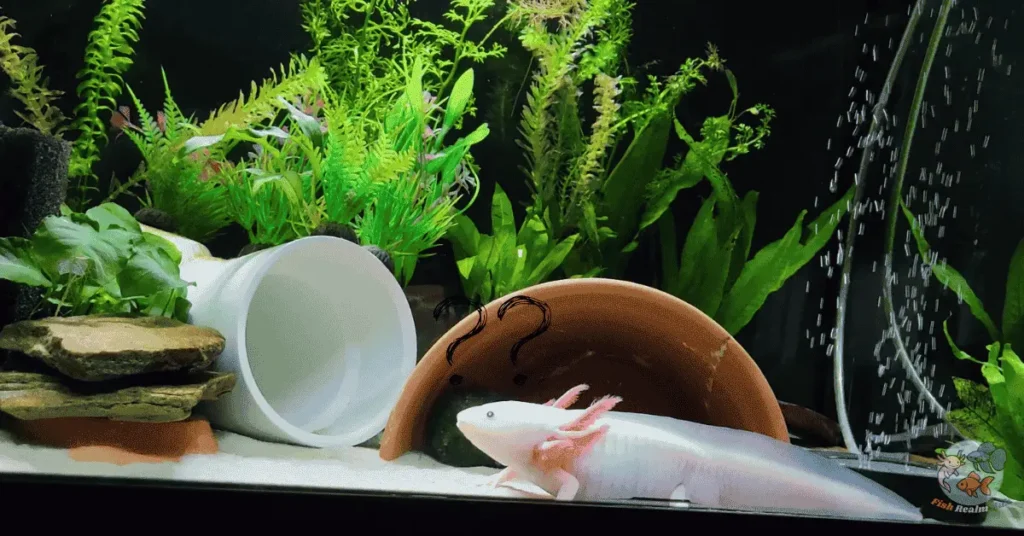When I first got my Axolotl, I was just an excited new owner with little clarification on how to look after such a less common pet. I quickly realized that a proper Axolotl tank setup is the key to a healthy and happy life for this adorable creature. These pets are surprisingly active, and they love interacting with their owners, so giving them enough space to move is very important.
One big question I had was, can axolotls live in a fish tank? The answer is yes, but not just any fish tank, it needs to match their specific needs, especially if you’re planning an Axolotl tank setup for small spaces.

Over time, I began to learn the correct care procedures by reading every guide I could and by watching how my axolotl behaved and grew in its environment. From their appearance to their unique behaviour, everything about them is a rewarding experience if cared for properly.
Being an aquarist now, I can confidently say that your plan to own one should start with understanding the right tank setup. Their diet, lifespan, and day-to-day caring all connect back to the size and setup of the tank. Providing the best care means choosing the right space, even if you live in a compact area, and that’s where small-space tank strategies really shine.
Axolotl Tank Size
When I first brought home my Axolotls, I realized that even though they may look calm, they’re actually quite active and love to explore. These unique pets need enough space to swim freely and play, so a small tank can really limit their movement. While a 10 gallons Axolotl tank is the bare minimum they need to survive, I’d strongly recommend going for a 20-gallon or even a 30-gallon if you have the room.
A larger tank gives them more space to move around and feel settled in their surroundings.A bigger tank also helps with the messy side of things—Axolotls create a lot of waste, and in a smaller tank, this means ammonia and nitrate can build up fast. This is dangerous for their health, especially since they have permeable skin and are sensitive to water changes more than other animals.
A good water-to-waste ratio makes it easier to maintain clean conditions and lowers the risk of health issues. Plus, it saves you from having to clean the tank too frequently.To keep them healthy, it’s important to monitor specific water parameters regularly. I always ensure the temperature stays between 15.5°C and 17.7°C, pH between 6.5 and 7.5, and hardness between 7 and 8 dKH.
These match the natural habitat conditions, and I try replicating them as closely as possible. I also do regular water testing to catch any imbalance early. A proper Axolotl tank setup is essential if your Axolotls are to live well—the correct size tank really makes all the difference.
Best Size Tank for a Baby Axolotl
When it comes to baby axolotls, they usually do not follow the same guidelines as adults when stocking an axolotl aquarium. A baby axolotl just a few inches long can almost disappear in a 20 gallon tank, making it difficult to feed them properly—especially since these tiny babies need frequent feedings.
That’s why I always start with a smaller tank or even a tub, which makes life easier during those early stages when they’re not yet big enough to hold its own in a full aquarium.From my experience, baby axolotls grow quickly, about an inch a month until they’re around 8 months old.
So even if they do fine for a short time in an undersized environment, you’ll need to upgrade to a full size aquarium sooner than you may have thought. Some hobbyists, including myself, also use a breeder box to contain the baby before introducing it to the main tank—a useful trick if your small one needs to catch up to a larger one.
Maintenance
From my experience, going for a larger tank is a smart choice if you live a busy life and want to reduce how often you need to do water changes. A bigger aquarium not only fits your animal better, but also holds more water volume, which helps dilute the toxins, waste, and other byproducts that naturally build up. These are handled by the biological filter, but in smaller tanks, the nitrate buildup can happen fast and requires more frequent attention.
However, it’s not always that simple. One important factor is the filtration. If your filter is weak or even nonexistent, even a large tank can turn into more work than a smaller one. I’ve seen setups where just changing one part flipped the whole situation. A powerful, good filter can make maintenance much easier and turn a high-volume tank into a real plus. So in the end, it’s all about finding the better fit and balancing your setup with the right equipment from the beginning.
Floor space
When setting up a tank for your axolotl, one of the most important things to think about is the floor space. These Mexican walking fish love to spend time slowly walking, standing in one spot, or just resting. They don’t swim much, so giving them more room to walk around on a flat, plain surface matters more than having a tall tank.
From my own experience, a shallower, wider setup like the lowboys often used in aquariums makes ideal homes for your axie. These tanks have more usable floor space, unlike the regular fish tanks that are often too deep without much benefit.If you already have a tank that doesn’t offer a lot of floor space, there are still ways to make your aquarium feel bigger for the animal.
By providing fun decorations like large rocks, hides, hammocks, and other objects, you can create areas to crawl and play. This effectively converts some of the unused height space into more interactive walking space. It might even be more interesting for your axolotl than just having further distance to move on a dull floor.
Faqs
How big of a tank does 1 axolotl need?
For a single axolotl, choosing the right tank is very important. From my experience, a 20 gallons setup is the bare minimum, but a larger size—ideally between 29-40 gallons—is strongly recommended. Axolotls are quite active and naturally produce a good amount of waste, so having more space helps to maintain water quality. It also gives them room to swim, explore, and supports their long-term health and well-being.
Is a 20 gallon tank big enough for an axolotl?
A 20-gallon tank can technically hold a single axolotl, but it’s really the bare minimum. From what I’ve seen, it demands frequent maintenance to keep the water quality safe. A larger setup like a 29-gallon or 40-gallon is generally recommended to ensure better space for natural movement and overall comfort.
Are axolotls high maintenance?
Axolotls are moderately high in maintenance but not extremely demanding. They’re relatively hardy, yet still requiring specific care like a cold water environment, often with a chiller, and a tank setup that’s free of gravel or small rocks. Their natural messiness means regular changes are needed to keep things clean.How often should I feed an axolotl?

